Menu
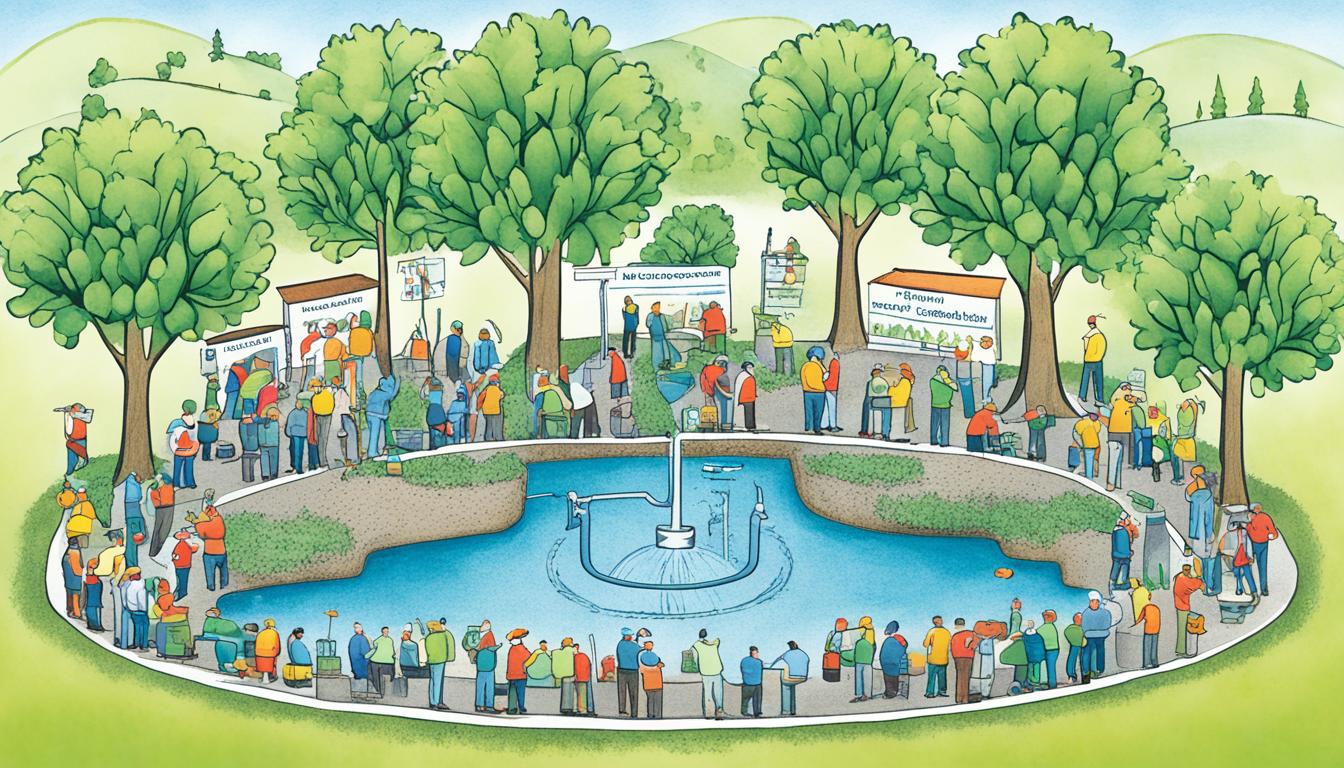
Groundwater makes up almost 95% of the freshwater we can use. This fact really stood out to me as I looked into managing groundwater. More than half the world depends on it for drinking water, showing how vital it is. With climate change and water shortages, we must manage it well.
In California, Governor Newsom has taken steps to deal with less water because of the changing climate. He introduced a new Water Plan during a snow survey. This plan focuses on big areas to make sure water remains available. It uses projects like Flood-Managed Aquifer Recharge to store water. It also uses climate science to protect water from too much or too little.
California is also spending a lot to improve its water systems and to hold more water. This effort shows how broad their plan is. They aim for sustainable water use and to fill the underground water sources. This goal needs smart monitoring and new ways to handle water.
Groundwater management is key to many industries, like agriculture, and to our homes. It plays a big role in California, providing 40 to 50 percent of its water, even more in dry times. So, understanding and managing groundwater are essential.
Groundwater is very important, serving many needs. California heavily relies on it to water crops and for city use. California has laws, like the Sustainable Groundwater Management Act (SGMA), to protect about 96 percent of its groundwater.
Managing groundwater faces many problems, such as too much use, pollution, and changing weather. California uses more groundwater than is naturally replaced, about 1 to 2 million acre-feet every year. To tackle this, specific and strict rules for well use and technology are necessary.
To keep groundwater for the future, local areas must make plans. These plans need to carefully track water use, find ways to pay for managing water, and set limits on pumping. Basically, by 2040 or 2042, local areas need to keep their groundwater sustainable, or the state will get involved.
| Challenge | Scope | Management Strategy |
|---|---|---|
| Over-extraction | 1-2 million acre-feet per year | Sustainable pumping limits |
| Contamination | Widespread | Improved monitoring and treatment |
| Climate Change | High variability | Adaptive management strategies |
Overall, protecting groundwater needs good management and strict policies. With the right knowledge and tools, we can use groundwater wisely and keep it for the future.
The new California water plan is key to meeting the state’s growing water needs. It looks at capturing more water, better storage, and using climate science to build resilience. This plan aims to make sure we have enough water for the future while tackling issues today.
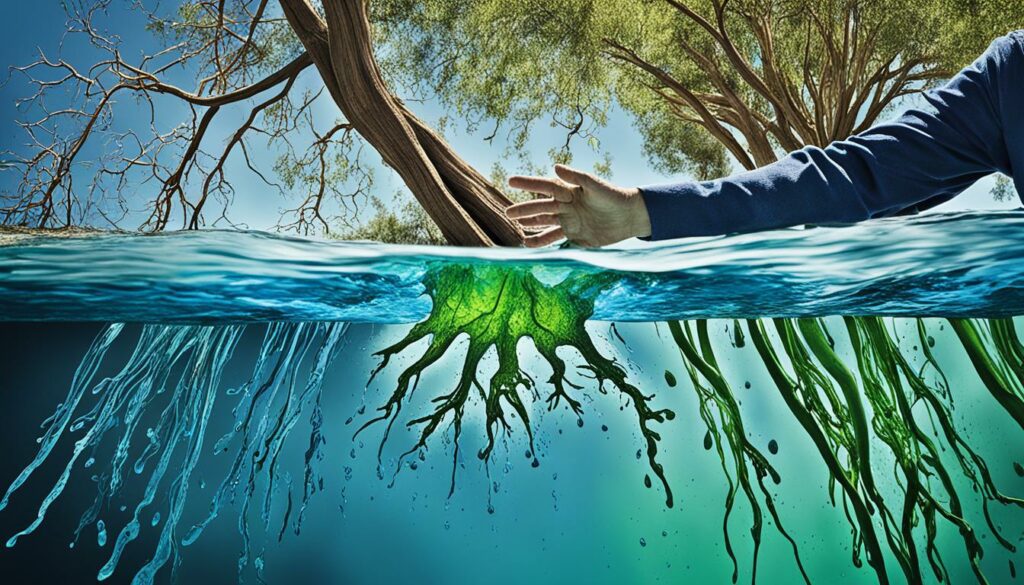
The California water plan wants to make sure we have water sustainably. It focuses on recharging aquifers. This is to fight against overuse and drought. Since groundwater makes up a big part of our water supply, managing it well is a must. The plan will improve how we store water and refresh supplies.
The Flood-Managed Aquifer Recharge (Flood-MAR) scheme is critical. It uses floodwaters to refill depleted aquifers, lowering the risks of both floods and drought. Each year, 1-2 million acre-feet of groundwater is lost through pumping more than nature can refill. The Flood-MAR program directs extra water into aquifers. This helps stop water levels from dropping and wards off future shortages.
Using climate science is vital for our plan. It helps us make smart decisions for adapting to climate change. This is especially important for places like the Central Valley, facing serious groundwater drops. With our population expected to hit 50 million by 2040, we need to be ready to protect our water supplies.
California is fighting the challenge of less water due to hotter, drier weather. Initiatives like the Water Resilience Portfolio and Water Supply Strategy are helping. By working on better water storage and recharging aquifers, the state is preparing for the future.
| Key Statistics | Details |
|---|---|
| Groundwater Supply in Normal Years | 40% |
| Groundwater Supply in Drought Years | 60% |
| Annual Groundwater Depletion | 1-2 million acre-feet |
| Population Projection by 2040 | 50 million |
It’s vital to use water in sustainable ways for the future. This means everyone must focus on saving water in agriculture, industry, and at home. To do this, we need to use water more carefully and find ways to avoid wasting it.
Using water-saving methods is key to cutting down waste. Drip irrigation and rainwater harvesting are great examples. These methods save water and help replenish our groundwater. The U.S. EPA shows how much we rely on this water, so it’s very important to protect it.
Smart irrigation technology and soil moisture sensors can also help a lot. They ensure we use just the right amount of water. This not only saves water but also helps keep our groundwater healthy for the future.
Being efficient with water is crucial, especially with climate change. For farming, using techniques like crop rotation is very helpful. It saves water while still growing food. This way, farmers can keep their farms productive without using too much water.
| Water Source | Percentage of Usage |
|---|---|
| Groundwater (Community Water Systems) | 75% |
| Groundwater (Agricultural Irrigation) | 42% |
The SGMA law aims to make sure we use groundwater wisely. It encourages groups to come up with plans to keep our water sources safe for the future. This law is important for efficient water use and can be a model for other places too.
Using water sustainably helps us meet current needs and those of future generations. By working together to save water and use it wisely, we can protect our water for a long time.
Managing groundwater well is crucial because it serves drinking water to millions in the U.S. It’s key to know the status of aquifers to keep this water source safe. Monitoring these locations on a regular basis is important to the process.
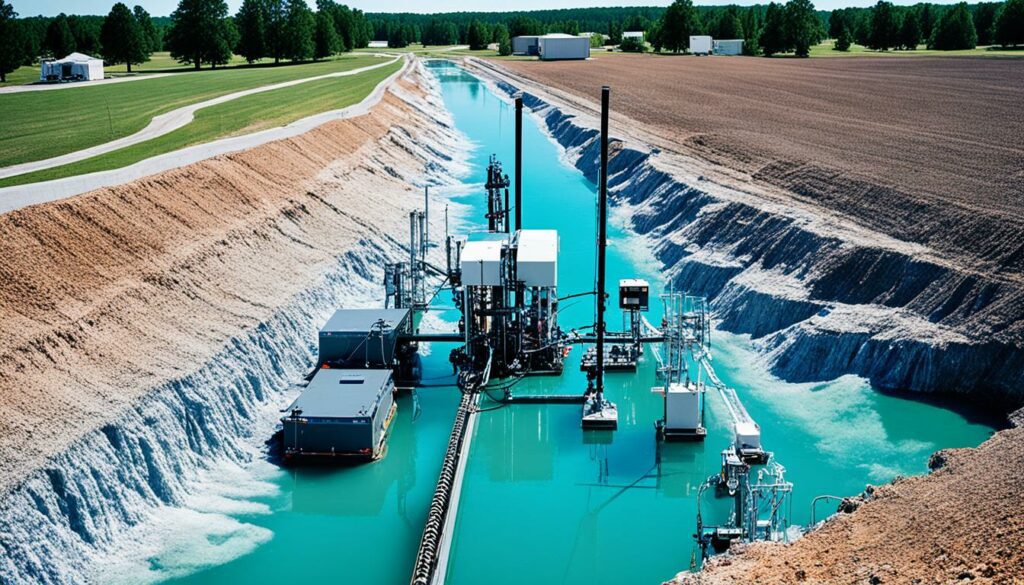
Diverse aquifer monitoring technologies have come into being. They allow in-depth observation, providing a wealth of information. By using models that combine physical aspects with vast data, experts can better understand aquifers.
These models use cutting-edge methods like artificial neural networks and genetic programming. They also employ finite differences and finite elements. These tools help in simulating how groundwater flows, making the whole process more accurate.
Monitoring helps us in many ways. It gives us vital information for using water wisely and warns us about dangers like pollution early. This is crucial to avoid over-pumping, which is happening in places like California, endangering water supplies.
Also, advanced monitoring tools and water resource management tools help with scientific study. They’re important in linking what we know in theory with practical water management. This type of research is essential to protect our water for the future.
Using the right methods to recharge groundwaters is key. This is especially true in places like California. California heavily depends on groundwater. Up to 60% of its water comes from underground in dry times.
Managed aquifer recharge (MAR) brings surface water into groundwater areas. In California, the ground can hold over 850 million feet of water. This is a lot more than the 50 million feet of water in its reservoirs. Efforts like the Temporary Flood Diversion Equipment aim to speed up getting water underground. They even allow for exceptions from certain rules to make this happen.
Flooding water into areas like the Tulare Basin is key for keeping water around for a long time.
Natural methods use the land to keep our water levels up. By removing obstacles through things like rip and chip, the water flows better. Senate Bill 122 of 2023 in California is a new law supporting these natural ways. It makes using the land to help fill water supplies better.
Also, using rainwater and recycling urban water is important. These actions help save water, especially in dry and crowded places.
| Strategy | Method | Details |
|---|---|---|
| Managed Aquifer Recharge | Surface Water Diversion | Intentional redirection of floodwaters to replenish groundwater basins. |
| Natural Recharge Methods | Ecological Processes | Enhancing natural infiltration through land clearing and rip and chip activities. |
| Demand-Side Management | Efficiency Improvements | Interventions such as subsidies on rural electricity and well drilling to manage groundwater use effectively. |
| Supply-Side Measures | Rainwater Harvesting | Encouraging rainwater capture and urban wastewater reuse to augment groundwater supplies. |
Using both managed methods and natural ways are important. Along with saving water smartly, these steps can keep our water sustainable. This is not just for California but for many places.
Arizona takes a forward-thinking approach to manage its groundwater. It uses the Phoenix Active Management Area (AMA) Groundwater Model. This model is key in predicting future water levels and suggesting ways to avoid shortages.
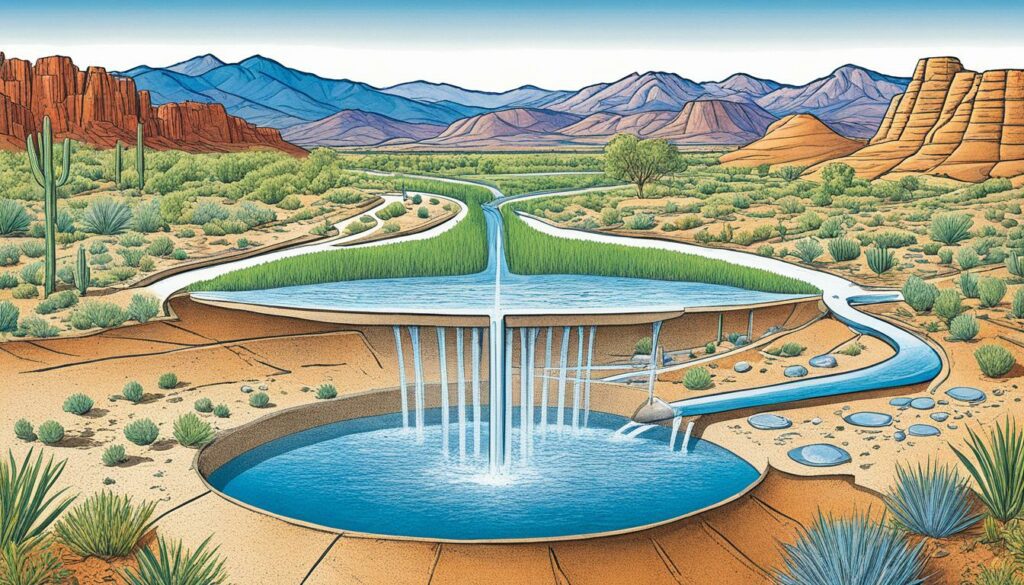
The Phoenix AMA Groundwater Model is crucial for Arizona’s water management. It covers areas with over 75 percent of the state’s people. The model can predict groundwater levels for the next 100 years.
Arizona aims to reach “safe yield” by 2025, taking out only what nature can safely replace. Developers must secure a 100-year water supply for new projects. This shows how serious Arizona is about its water supply.
The American Rescue Plan Act is providing a big boost to Arizona’s water projects. The state aims to use less groundwater, especially in areas where the aquifers are stressed. It’s working to ensure water is used sustainably across the board.
This financial help is critical for moving away from relying too heavily on groundwater. It’s helping not only urban areas but also rural places facing water stress. This balanced approach is important for managing Arizona’s water wisely.
| Indicator | Value |
|---|---|
| Groundwater use in AMAs | 31% (Phoenix), 42% (Pinal), 39% (Tucson) |
| Annual groundwater consumption | Less than 7 million acre-feet |
| Population increase since 1957 | 500% |
| Population residing in AMAs | 75% |
| Groundwater overdraft target year | 2025 |
Arizona is combining the Phoenix AMA Model with funding from the American Rescue Plan Act. This mix is moving Arizona towards a secure water future. It’s a strong strategy that highlights careful planning and smart investments for a lasting water supply.
Hydrogeology is key to managing groundwater. This field is all about understanding aquifers. Hydrogeologists help us know how groundwater moves, where it goes, and its quality under the ground.
Models for managing groundwater use maths and simulations. They predict and keep water levels safe. These days, computer models are really important for checking water resources correctly.
There are two main types of models: physical and data-driven. Knowing about aquifers from these models helps in planning how to use water. Lately, using computers to model water has become more common and cheaper than just physical models.
Better ways to mine and analyse data have improved managing water. Making water safe for people, farming, and jobs relies a lot on science about water underground.
Water scientists play a big role in helping water managers understand how to look after water supplies.
| Region | Oklahoma |
|---|---|
| Total Groundwater | Over 390 million acre-feet (AF) |
| Water Use | Source |
| Agriculture Irrigation | 80% from groundwater, >90% in drier years |
| General Water Use | Approximately half of all water used |
| Shallow Recharge Rates | 0.2 to 10 inches per year |
Hydrogeology is vital for keeping our water safe and plentiful. It helps us understand how to use water wisely. This way, we can meet our needs and also protect the environment for the future.
Tackling groundwater contamination is critical for keeping our water safe. It involves finding and fixing pollution, as well as stopping it before it happens. Recent studies highlight pollutants like PFAS and 1,4-Dioxane, warning they could harm public health.
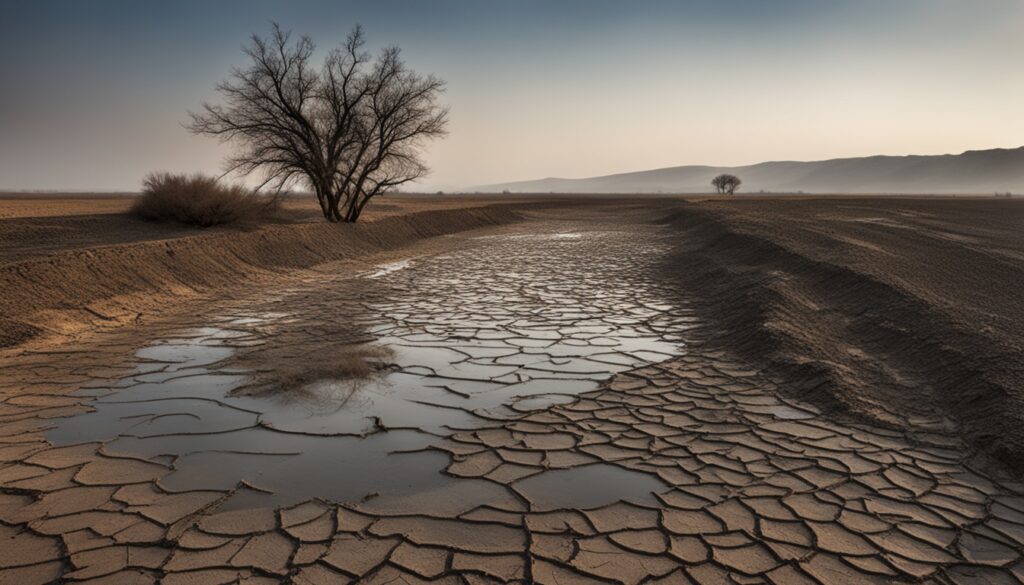
Products with PFAS have been used a lot in the last 80 years. This has spread contamination through many U.S. water systems. The EPA is working to set drinking water limits for some PFAS. They also say fixing 1,4-Dioxane is very important for our health.
Contaminated groundwater is not just a health issue; it is also costly. Cities and districts spend a lot on cleaning up, monitoring, and meeting rules. Everyone must help prevent pollution at home, work, and in their communities.
| Level | Strategy | Example Actions |
|---|---|---|
| Home | Reduction of Pollution |
|
| Workplace | Pollution Prevention |
|
| Town Management | Policy and Education |
|
Drinking water polluted with PFAS and 1,4-Dioxane is dangerous. It can cause cancer, hurt organs, and change hormones. To keep us safe, water services must watch and stop these contaminants.
These pollutants harm people, nature, and the economy. This shows why we all need to work together to keep our water clean.
There’s a growing focus on cleaning up contaminated groundwater. Innovative groundwater remediation techniques are key. They ensure water is safe for both people and nature to use.
Bioremediation is a game-changing method in bioremediation innovation. It uses living things to break down harmful substances in the water. These get turned into safe materials. It’s known for being good for the Earth. In 1995, studies found it works great, especially on radioactive water pollutants.
There are also ways to clean water through physical and chemical means. “Pump and treat” is a common method that’s proven to work. But new environmental and economic needs push us to try different routes. For example, special materials now work better in cleaning up dangerous waste. A CD guide provides key info on these new methods.
| Stage | Percentage of Applications |
|---|---|
| Design Phase | 44% |
| Under Construction | 42% |
| Completed | 14% |
Recent data shows more and more use of new groundwater remediation techniques. They’re quicker and cheaper, aiming for a sustainable future with safe water for all.
The U.S. Department of Agriculture (USDA) works hard to fight climate change. They focus on making sure farms can handle less water and use water better. A big effort is in the Upper Mississippi River Basin, looking at six American states. This plan started by improving farms there. Now it’s also helping areas near the Great Lakes and the Red River Valley.
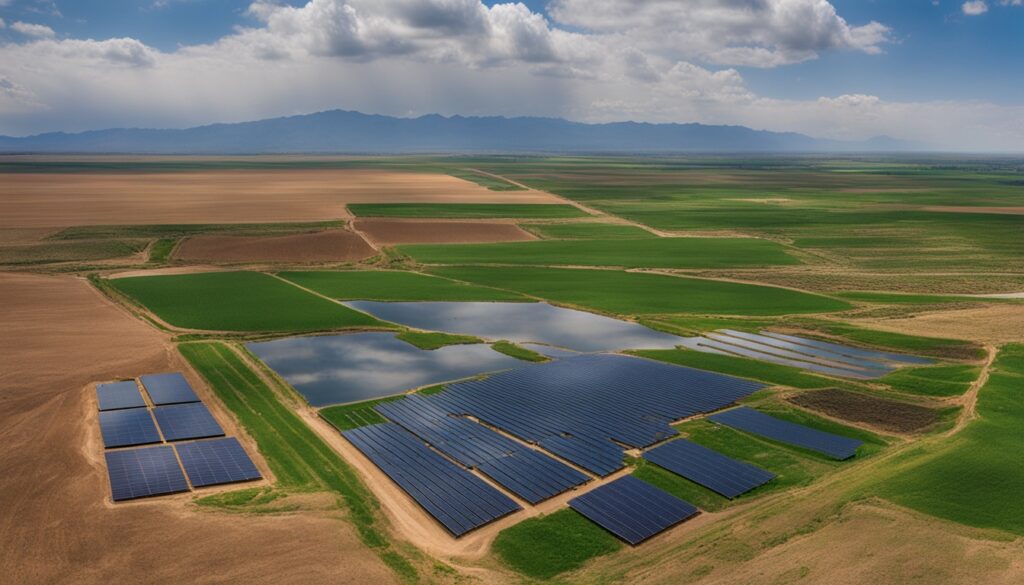
This work broadened because farming was harming huge rivers and lakes. Nutrients from farms were polluting these waters. The USDA now supports ways to manage farm water better. For instance, they’re using devices that clean the water and putting plants near drains to catch harmful stuff.
The Inflation Reduction Act’s support is key for making these water-saving plans work. This Act’s money helps make sure the programs are set up right. The AGWAM team leads the way, made up of experts from the government and academics. They help farmers use the latest ways to save and clean the water.
There are graphs and charts that show how well these water projects are doing. They clearly show improvements in the water and how much has been saved. But, more work is needed, as water in some places might drop by 20% by 2040. That’s why these projects are so important now.
Without these efforts, huge areas of farmland might not be used, and many people could lose their jobs. The economy could also get a big hit. But with the right plan and funds to save water, we can keep farms going. This way, water and farming can survive in a changing world.
The backbone of good groundwater management is local and state government policies. These rules make sure water is used sustainably and support efforts to save water. Since up to 60% of California’s water comes from underground, these strict rules are crucial.
The Sustainable Groundwater Management Act (SGMA) aims to make sure we use underground water wisely. It sets goals for how quickly different areas need to improve their water use. By 2040, some areas must get better, with others having until 2042. The California Department of Water Resources and a state board check on progress to keep everyone on track.
Communities play a big part in saving water too. When people understand the value of water, they take better care of it. About 33 million in California use groundwater daily. This shows how crucial it is for communities to work together.
Getting locals involved helps achieve fair and smart water use. Government policies also back up these efforts. Together, everyone can make a big difference.
| Aspect | Details |
|---|---|
| Legislative Support | SGMA mandates, regular DWR assessments, state interventions |
| Community Participation | Local engagement, grassroots stewardship, public reliance |
| Groundwater Reliance | 33 million Californians, 40%-60% state water supply |
Climate change is a big challenge for groundwater around the world. It leads to different rainfall, changing temperatures, and rising sea levels, all affecting groundwater access and quality. To deal with these issues, we must be able to adjust our groundwater management.
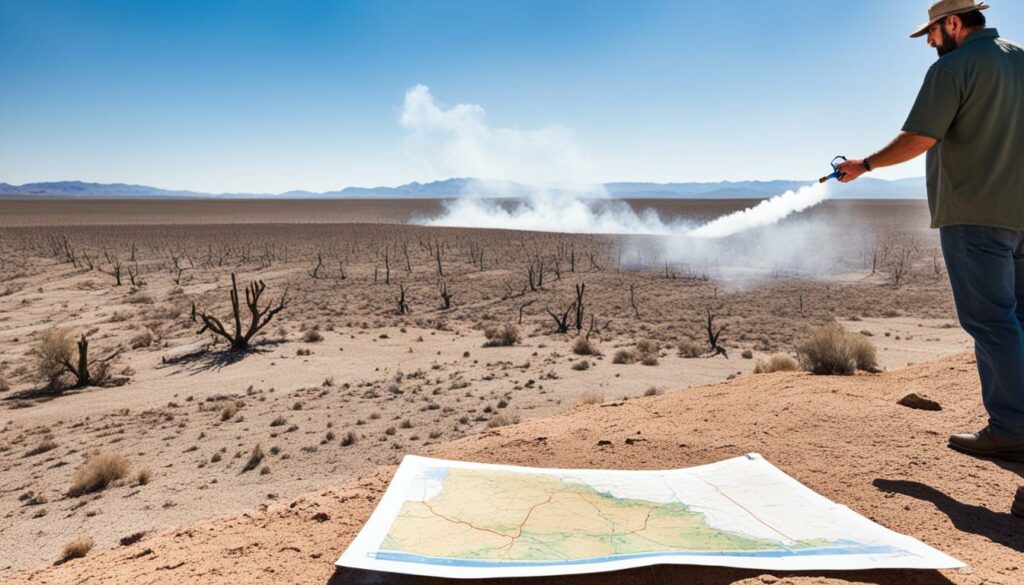
Climate change affects groundwater in big ways. It makes rainfall and droughts longer, and floods stronger. This, in turn, changes water table levels. Small aquifers can dry up during long droughts. Also, sea level rise makes salty water move into fresh water sources, making it harder to find clean drinking water.
To tackle these problems, we need new ways to manage groundwater. One smart method is Managed Aquifer Recharge (MAR). It boosts fresh water supplies and helps us adapt to climate change. Studies from the International Groundwater Resources Assessment Centre show that MAR can work well in different places.
Also, projects like the Global Groundwater Monitoring Programme help spread better water management ideas. They have held helpful workshops in the Pacific islands. These help the islands and other vulnerable areas learn how to manage their water resources better.
Moreover, the GTN-H project aims to make water data more available. This is key for managing groundwater better. They, along with the Global Overview of Saline Groundwater Occurrence, help us understand where salty water is affecting our fresh sources. This helps us create better plans for water management.
| Impact | Details |
|---|---|
| Water Table Variation | Longer droughts and increased flooding due to climate change can lead to significant fluctuations in water tables. |
| Saltwater Intrusion | Rising sea levels result in saltwater encroachment into coastal aquifers, affecting freshwater quality. |
| Adaptive Strategies | Initiatives like MAR and research by IGRAC on local and regional levels support adaptive groundwater management. |
| Research and Monitoring | Programmes like GGMN and GTN-H provide essential data and insights for managing saline groundwater and enhancing adaptation strategies. |
We’re learning more about how climate change impacts groundwater. As we learn, we need to adapt our management. By using new, smart techniques, we can manage our water resources better and be ready for climate change.
Keeping groundwater sustainable is tricky and needs many strategies. South Africa took a step forward by creating a team to manage water use at home. This shows how we should prepare for future water needs. Traditional and new ways of managing groundwater show the costs can be different. One issue is not having enough people to look after it.
We now use high-tech methods like linear programming to better look after water sources. Using information and models from machines helps too. These new ways have changed how we handle groundwater, but we still need to research more. This will help make what we learn work in the real world.
In places like Arizona, US, people have started using a lot more groundwater, even buying land for farming. There have also been water thefts in California and the Ogallala Aquifer drying up. These events show we need to act fast to protect our water. The argument over water between Mississippi and Tennessee also tells us that handling water issues between places can be hard. With climate change, we need to plan well to make sure we have enough water for the future.
Groundwater management is key for our water needs. It supports farming, industry, and homes. To keep it clean and steady, we must tackle over-use, pollution, and climate shifts.
The big issues are too much extraction, pollution, and changing climates. These make it hard to keep water safe and enough for everyone.
California’s new Water Plan, announced by Governor Newsom, focuses on big-picture water management. It aims for water to cope better with climate changes. It uses schemes like the Flood-Managed Aquifer Recharge to save water for dry times.
This plan pushes unused rainwater back into aquifers. It’s a smart way to save water for when we need it, making water use more sustainable.
Using climate science helps protect against water problems from climate change. It’s vital for planning how to deal with both hot and dry weather better.
Good water saving ways include using less, using water again, and being smart about how we use it. This helps in farming, making things, and at home.
Scientists use special tools like sensors and data software to watch over aquifers. They can see how much water’s there and figure out if it’s clean to use.
Checking aquifers often is key in using water right. It finds any water risks early, like pollution. This knowledge helps in making smart water use plans.
Managed aquifer recharge is about putting extra rainwater back into aquifers. It keeps groundwater levels stable and helps in managing water better.
The Phoenix model looks ahead at water levels for 100 years, pointing out actions to avoid water shortfalls. It guides smart water use plans.
Hydrogeology teaches us about water under the ground and how we can use it well. It looks at natural and human influences on water quality and amount.
To tackle pollution in groundwater, find the source and clean it up. Plus, stop more pollution from happening. This keeps water safe for all.
New ways to clean water include using living things to break down pollutants. Also, there are high-tech and chemical methods for purifying water.
The USDA supports water saving, handling climate changes, and getting ready for droughts better. It’s backed by funds from the Inflation Reduction Act.
Local and state laws are key for looking after water well. They get everyone involved in saving and using water wisely, starting in local areas.
Changes in the weather can lower water levels underground. We need to change how we manage water to keep our water supply strong against these changes.